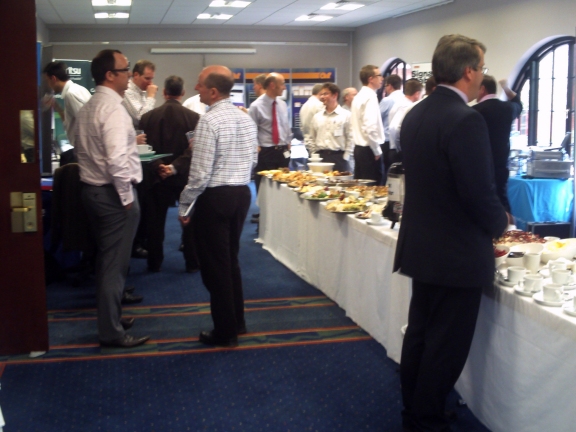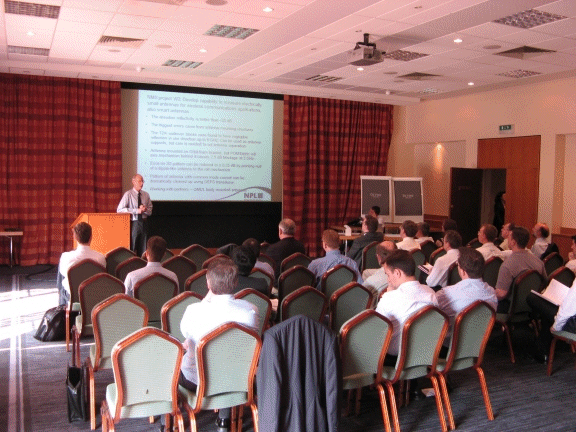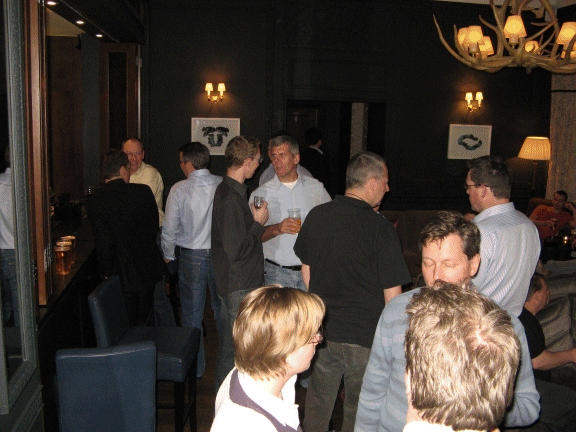 |  |  |
Milton Hill House
Steventon
Oxfordshire
OX13 6AF
| Tel | 0870 609 1153 |
| Web | www.devere.co.uk/venues/Milton-Hill-House/ |
Dr Steve Nightingale
Cobham Technical Services
| Tel | 01372 367121 |
| Steve.Nightingale@cobham.com |
A 100kHz to 6GHz Fast Scanning Receiver for under £1000 | |
| John Lillington | |
| Libra Design Associates, Ltd | |
| The original design brief was to achieve a receiver capable of scanning a band from 100 kHz to 6 GHz in less than 1 second. With an instantaneous bandwidth of up to 20 MHz and a final IF to feed a digital receiver with around 100 Msps sample rate. A minimum signal sensitivity of -107 dBm and a dynamic range of at least 80 dB, presented many design challenges to overcome, especially within a budget of £1k production cost. The paper covers the derivation of the requirement specification, choice of system architecture and frequency plan, specific design issues and the measured results. | |
| A 100kHz to 6GHz Fast Scanning Receiver for under £1000 | |
A Brief Introduction to Glass Microwave Integrated Circuits (GMIC) aimed as an Enabling Technology for Millimetre-Wave Sensor Applications | |
| Derek Wyncoll | |
| Cobham MAL | |
| This paper presents a novel solution aimed at millimetre-wave applications that offers a ‘mid-way’ option between conventional small to medium scale techniques and custom MMIC development. | |
| A Brief Introduction to Glass Microwave Integrated Circuits (GMIC) aimed as an Enabling Technology for Millimetre-Wave Sensor Applications | |
A High Linearity FMCW Sweep Generator | |
| Craig Winter | |
| Cobham Technical Services | |
| Linearly swept Frequency Modulated Continuous Wave (FMCW) sources are widely used as the basis for RADAR systems. This approach enables good resolution and range without the need for short pulse, high peak power transmitters and is thus well suited to solid state systems and millimetre wave operation. Cobham Technical Services have developed a K-band sweep generator with the linearity and wide sweep range necessary to form the heart of a high resolution RADAR system. The sweep generator is a fully synthesised using a hybrid architecture with both DDS (Direct Digital Synthesiser) and PLL (Phase Locked Loop) elements. This compact solution generates sweep rates of 1kHz, with a deviation of 1.5 GHz or 8%. The spurious levels are typically less than -80dBc and the sweep linearity better than 0.01%. The frequency source has been multiplied up to V-band where it enables an instrumentation RADAR to achieve better than 3cm resolution. | |
| A High Linearity FMCW Sweep Generator | |
Enhancement mode GaN-based MOS-HEMTs | |
| Edward Wasige | |
| University of Glasgow | |
| We are developing a totally new method for fabricating enhancement mode GaN-based HEMTs using the conventional AlGaN/GaN material system. We use localized gate-foot thermal oxidation of the AlGaN barrier layer. Oxidation of the barrier layer converts it to aluminium and gallium oxides, which serve as a good gate dielectric and improve the gate leakage current by several orders of magnitude compared to a Schottky gate. But this is not straight forward as it seems. Without special precaution, the oxidation of the AlGaN barrier is not uniform from the top but occurs at higher rates at the defect/dislocation sites making it impossible to control the barrier thickness and so rendering the barrier useless. We have developed a simple but effective technique which enables us to uniformly thin the barrier via oxidation and initial results indicate E-mode operation can be achieved this way. E-mode GaN-based devices are well suited to high-speed, high-power switching applications. Also, since both the AlGaN/GaN-based E-mode devices and the conventional D-mode AlGaN/GaN devices can be made on the same wafer, an E/D device technology for realisation of GaN-based logic circuits is potentially available. | |
| Enhancement mode GaN-based MOS-HEMTs | |
Fractional-N PLL based Frequency Sweep Generator for Automotive FMCW Radar | |
| Austin Harney | |
| Analog Devices | |
| There are 42,000+ annual road fatalities in the EU and over 1 million fatalities worldwide. A key element in reducing road fatalities in the future is the improvement and merging of the various safety systems in cars. One emerging automotive safety system is collision avoidance. The presentation will introduce some of the various approaches to collision avoidance taken by automotive suppliers and then focus specifically about one of the approaches, namely FMCW Radar, and a compact and highly linear implementation of a FMCW sweep generator using the ADF4158 PLL from Analog Devices. This part can be used for systems developed for both 24GHz and 77GHz ISM bands. Measurement results will be shown and some conclusions made. | |
| Fractional-N PLL based Frequency Sweep Generator for Automotive FMCW Radar | |
I-V Waveform Measurement and Engineering Systems - addressing the High Power Amplifier Design Challenge | |
| Paul Tasker | |
| University of Cardiff | |
| This presentation presents an overview of the potential of RF waveform measurement and engineering to support the developments of transistors, circuits and systems that rely on strong non-linear affects. To date these concepts have mainly been focused towards aiding the development of RF power amplifiers (RFPAs). This is because the performance of RFPAs both exploits (efficiency) and is limited (linearity) by strongly non-linear affects. RFPAs are a critical component in many systems; e.g. mobile communications, satellite communications and radar systems. | |
| I-V Waveform Measurement and Engineering Systems - addressing the High Power Amplifier Design Challenge | |
Millimetre Wave Gunn Diode Technology and Applications | |
| Nigel Priestley | |
| e2v | |
| Gunn diodes have been used in military, commercial and industrial oscillator applications for the past forty years. In the case of millimetre wave operation, the Gunn diode continues to offer equal and superior levels of performance to MMIC technology. This paper will discuss the hot electron structures that have been developed over the past twenty years and more recent work that enables the tailoring of device characteristics to match specific applications and environmental environments. The importance of well controlled device packaging and heat-sinking design will be shown, with some results of the consequential reliability of Gunn diodes in production. The design of the Gunn diode oscillator is crucial so as to gain optimum performance and long term reliability; some mechanically tunable oscillator designs will be described before going on to present a patented novel ‘planar’ substrate oscillator developed for use at 77 and 94GHz. Work undertaken to successfully manufacture commercial 125GHz Gunn oscillators for millimetre-wave radar and imaging applications will also be presented. | |
| Millimetre Wave Gunn Diode Technology and Applications | |
Polymer Bonded LCP Device Housing enables Selective Thermal Management for RF Device Packages | |
| Andy Longford | |
| PandA Europe | |
| The development of broadband wireless communication systems has generated a rapid growth of RF component that need to meet the ever present need for “Smaller Faster Cheaper” electronics. Due to the high performance and increasing speed requirement of the systems, thermal management has become a key issue for the electronic components. This requirement has proved to be an obstacle for devices, inhibiting the use of lower cost plastic packaging, in favour of metal can parts. However recent developments in polymer bonding technology have enabled novel sealing techniques that allow the use of low cost plastic housings on a variety of thermally efficient, flat plate substrates. | |
| Polymer Bonded LCP Device Housing enables Selective Thermal Management for RF Device Packages | |
Quarzlock Model A7MX Frequency/Phase Difference Comparator Measurement of Microwave Sources | |
| Cosmo Little and Clive Green | |
| Quartzlock | |
| This presentation will describe the measurement of time domain stability of microwave and RF sources and passive devices between 20MHz and 40GHz. An outline of a suitable measurement will be proposed. | |
| Quarzlock Model A7MX Frequency/Phase Difference Comparator Measurement of Microwave Sources | |
RF Architectural Tools for the Modern System Designer | |
| Malcolm Edwards | |
| Applied Wave Research UK Ltd | |
| Current RF architectural tools available for system designers consist of a mixture of budget simulators, spur searching utilities and frequency planning tools. Often these tools or utilities are based on spreadsheets, or perhaps are hard coded algorithms with some user interface. The home brew utilities have a reputation of being poorly supported. The current drive for reducing time to market and efficient design flows means that engineers are no longer encouraged to build their own design utilities. Engineering managers prefer engineers to be designing products, not tools. This presentation aims to outline the types of utilities needed for RF architectural decision making and the benefits of having an integrated approach. We will show some good reasons why spread sheets have their limitations! | |
| RF Architectural Tools for the Modern System Designer | |
The Behaviour and Characterisation of circuit Materials at High Millimetre-Wave Frequencies | |
| Nural Osman | |
| University of Surrey | |
| With more communication systems moving into the millimetre-wave frequency range there is a need for accurate data on circuit materials being used at these very high frequencies. Modern techniques for characterizing materials at high mm-wave frequencies will be discussed, and supported by practical measured data on typical materials. The materials investigated will include alumina and LTCC (low temperature co-fired ceramic), whose properties make them particularly attractive for single layer and multilayer circuits in the high frequency range. | |
| The Behaviour and Characterisation of circuit Materials at High Millimetre-Wave Frequencies | |
The Design of E-band MMIC Amplifiers | |
| Liam Devlin | |
| Plextek Ltd | |
The worldwide availability of a large amount of spectrum at 71-76GHz and 81-86GHz (commonly known as 'E-band') for high data-rate wireless links has led to substantial interest. The design of electronic equipment at such high frequencies is challenging. Parasitic effects that were negligible at microwave frequencies become problematic and the availability of suitable active components is very restricted. The development of custom GaAs MMICs offers a route to realising low-cost, reproducible E-band components. This paper addresses the design and implementation of E-band MMIC amplifiers. It considers process selection, design challenges and practical approaches and presents the measured and modelled performance of a single-stage E-band gain block. | |
| The Design of E-band MMIC Amplifiers | |
The use of Higher Order Resonance Modes to shape the Radiation Pattern of Patch Antennas for use in Low Cost ISM Applications | |
| Nigel Gaylard | |
| Trimerix | |
| Low cost ISM applications are normally required to be very low cost and a printed antenna provides an obvious cost saving. Traditional fundamental mode patch antennas do not always match the desired radiation pattern and higher order modes can address this problem. | |
Time Domain Theory on a Network Analyser | |
| Clive Barnett | |
| Agilent | |
| This presentation will give a review of Time Domain concepts and their implementation in a Vector Network Analyser. Frequency truncation, discrete frequency sampling and windowing will be discussed together with their impact on measurement accuracy followed by a brief presentation of time domain gating and its uses in microwave circuit design. Where possible, practical examples will be presented to illustrate the use of the time domain. | |
| Time Domain Theory on a Network Analyser | |
Ultra Wideband Time Domain Radar Systems | |
| David Daniels | |
| Cobham Technical Services | |
| Detection of buried ordnance and landmines has proved to be a successful application of UWB radar technology, which after some years of research and development has now reached maturity in terms of production. This paper will review the technology that has been implemented in production systems and describe some current research and development into hand held and vehicle based radar systems The paper will also highlight the future engineering challenges to achieve not only detection but recognition and identification using UWB radar. | |
| Ultra Wideband Time Domain Radar Systems | |
As usual there was an accompanying exhibition. Companies wishing to exhibit at future meetings should email: exhibition@armms.org
Contributions are invited with an emphasis on RF and microwave design, research, testing and associated subjects. An oral presentation will be made at the meeting and a written paper will be required for publication in the society digest, which is distributed to delegates at the meeting. Prospective speakers are requested to submit a title and a short abstract to the technical coordinator (see above) as soon as possible.
Click here to view our Guidelines for Authors
Click here to view our Publication Release Form